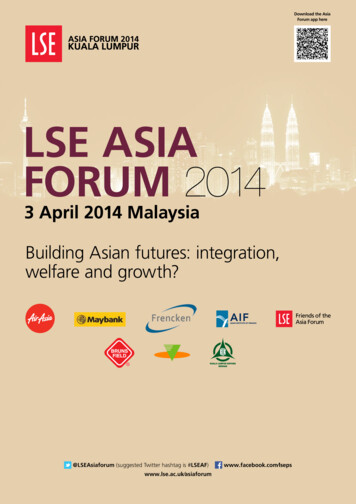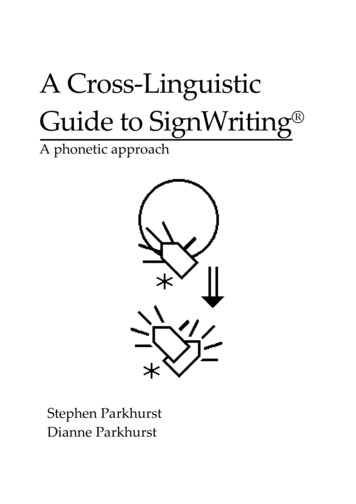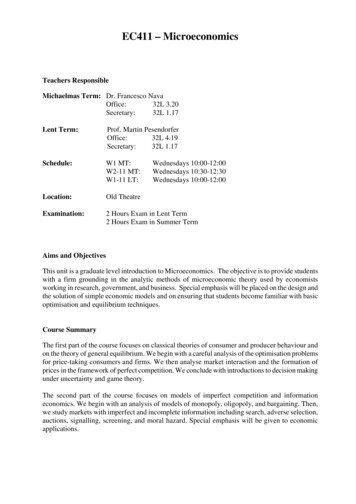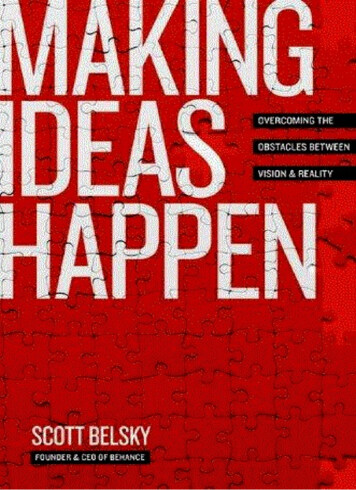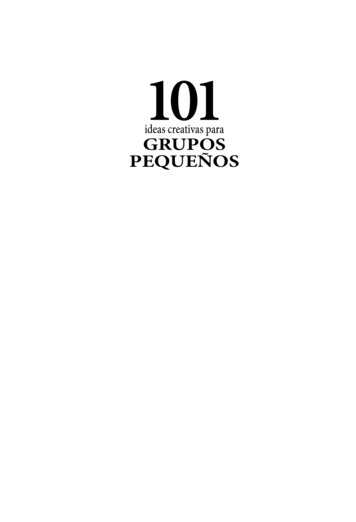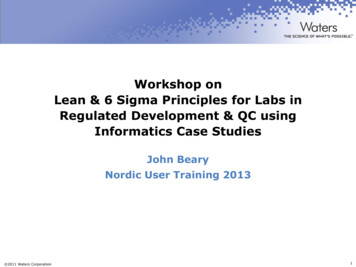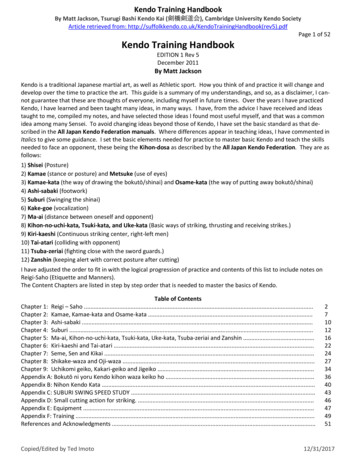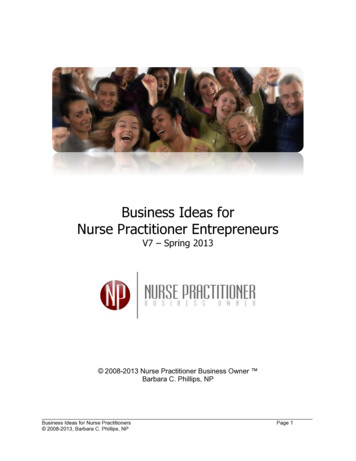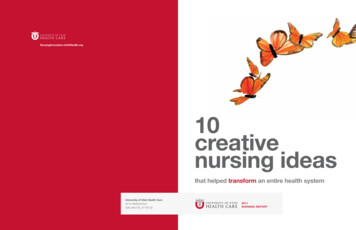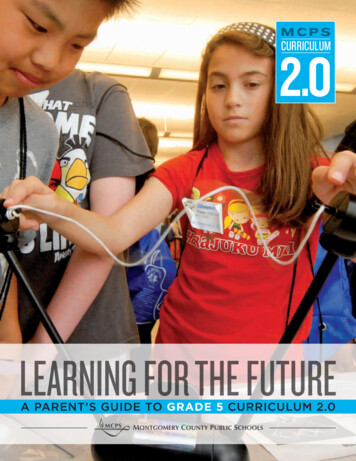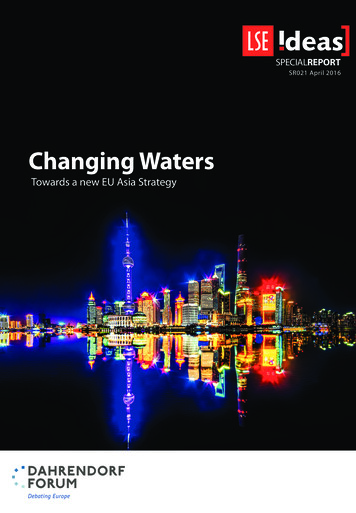
Transcription
SPECIALREPORTSR021 April 2016Changing WatersTowards a new EU Asia Strategy
EditorDr Olivia GippnerManaging EditorAlexander SoderholmIDEAS Reports EditorJoseph BarnsleyCreative DirectorIndira EndayaCover image sourcewww.flickr.com/photos/gags9999/(CC BY 2.0)LSE IDEAS is an Institute of Global Affairs Centrethat acts as the School’s foreign policy think tank.Through sustained engagement with policy makersand opinion-formers, IDEAS provides a forum thatinforms policy debate and connects academic researchwith the practice of diplomacy and strategy.IDEAS hosts interdisciplinary research projects,produces working papers and reports, holds publicand off-the-record events, and delivers cutting-edgeexecutive training programmes for government,business and third-sector organisations.The ‘Dahrendorf Forum - Debating Europe’ is ajoint initiative by the Hertie School of Governance, theLondon School of Economics and Political Science andStiftung Mercator. Under the title ‘Europe and the World’the project cycle 2015-2016 fosters research and opendebate on Europe’s relations with five major regions.
Changing Waters:Towards a new EU Asia strategyThe growth of Asian economies in the 21st century and the shuffling of thebalance of power through the US ‘Pivot’ to Asia will increasingly ask the EU and itsmember states to take positions in the relations with their Asian partners. Chineseresurgence and its impact on the region in addition to increasing investment inEurope and Africa have changed the dynamic of the EU’s interaction with the AsiaPacific away from development assistance to cooperation (and competition) ateye level. This also means an overhaul of the EU’s Asia strategy of 2001. Besidescreating continuity in a currently disconnected web of diplomatic and traderelations, a new strategy should provide a guideline for pooling resources, expertiseand networks of EU-China relations under a joint umbrella which is especiallybeneficial for smaller member states.This project puts forward analysis and concrete recommendations for an EU-Asiastrategy along the main tensions of security and political relations, developmentcooperation and climate change policy. The three main recommendations are;(i) an increased cooperation through Asian multilateral fora and non-traditionalsecurity issues, (ii) that the EU position itself as a neutral arbiter in a volatile AsiaPacific, and, (iii) increased focus on public diplomacy.
iv LSE IDEAS - Dahrendorf Forum Special Report. April 2016ContentsSPECIALREPORTSR021 April 2016ContributorsviExecutive SummaryOlivia Gippner1RALPH DAHRENDORF AND THE DAHRENDORF FORUMRobert Falkner4Developing regional capacitiesEU Strategy towards Southeast Asia and ASEANYeo Lay-Hwee6EU Regional Strategy in South Asia:Moving Beyond the Role of a Trade PartnerGarima Mohan13Towards a Strengthened EU Strategy towards Australia:Sharing Values, Respecting Difference, Consolidating Policy DepthPhilomena Murray19Developing Regional Capacities in Northeast Asiaand Making Strategic Partnerships Effective:A Strategic Approach for the EU towards Japan, Korea and TaiwanMay-Britt U. Stumbaum28China and EU Strategic Thinking on Asia:Towards a Strategic ‘Slim Down’Jan Gaspers and Bertram Lang38China-EU Relations: Old and New Great ExpectationsYu Jie49EU Policy in Burma/Myanmar: A Personal AccountRobert Cooper56
Changing Waters: Towards a new EU Asia strategy vCore areas of cooperationAsia as Part of the EU’s Global Security Strategy:Reflections on a More Strategic ApproachMichael Reiterer62What Place for Asia in the EU’s Strategy on Development Cooperation?Which Role for Europe in Asia? Any at all?Thomas Henoekl71Stepping up EU-ASEAN Cooperation in Non-Traditional SecurityReuben Wong and Scott Brown79Shifting Dynamics of Cooperation on Environment and ClimateDiarmuid Torney86CONCLUSIONUpdating the EU’s Asia Strategy?Olivia GippnerList of Abbreviations94100
vi LSE IDEAS - Dahrendorf Forum Special Report. April 2016ContributorsDr Scott A.W. Brown is currentlyTeaching Support Lecturer at theUniversity of Dundee, Scotland.His research primarily focuses onEU-US-China relations, with aninterest in comparative foreign policyanalysis. He runs the Jean Monnet/Erasmus funded module ‘EU-ChinaRelations’ (Decision No. 2014-1927).s.a.w.brown@dundee.ac.ukSir Robert Cooper is VisitingProfessor at LSE IDEAS and SeniorFellow of the Dahrendorf Forum. He isa retired British diplomat and formerAdvisor to EU High RepresentativesJavier Solana and Lady Ashton. Until2016 he was the Special Advisor atthe European Commission withregard to Myanmar.ideas@lse.ac.ukDr Robert Falkner is co-directorof the Dahrendorf Forum. He isAssociate Professor of InternationalRelations at the London School ofEconomic and Political Science andthe LSE’s Academic Director of theTRIUM Global Executive MBA, analliance between LSE, NYU SternSchool of Business and HEC Paris.r.falkner@lse.ac.ukJan Gaspers is Head of Researchof the European China Policy Unitat the Mercator Institute for ChinaStudies (MERICS) in Berlin, Germany.Previously, he worked as an Analystwith the RAND Corporation, wherehe led a wide range of European andtransatlantic foreign and securitypolicy research efforts.jan.gaspers@merics.deDr Olivia Gippner is a Dahrendorfpostdoctoral fellow on EU-East Asiarelations at LSE IDEAS. She holds aPhD in political science from FreieUniversität Berlin and the BerlinGraduate School of TransnationalStudies. Her research expertise is inclimate policy, EU-China relations andChinese policy-making.o.gippner@lse.ac.uk, @OliviagippDr Thomas Henökl is SeniorResearcher at the GermanDevelopment Institute in Bonn,working in research, teachingand policy advice in the fields ofEU foreign and security policy,international cooperation anddevelopment, and more widelyon comparative politics andorganization theory.thomas.Henoekl@die-gdi.deDr May-Britt U. Stumbaum is theDirector of the NFG Research Group“Asian Perceptions of the EU” at theFree University of Berlin and Editor ofthe Blog “The SPEAR – Security andPolitics in Europe-Asia Relations”. Herresearch focuses on Asian securityissues and implications for Europe atthe interface of policy analysis andacademic research.m.stumbaum@fu-berlin.deBertram Lang is a ResearchAssociate with the European ChinaPolicy Unit at MERICS. He studiedPolitical Science, EU InternationalRelations and Chinese in Freiburg, Aixen-Provence, Nanjing and Bruges. Hisresearch interests include Europeanand Chinese foreign and trade policy,anti-corruption policies and civilsociety organisations in Greater China.bertram.lang@merics.deDr Diarmuid Torney is a Lecturerin International Relations in theSchool of Law and Government atDublin City University, Ireland.He holds a DPhil (PhD) in InternationalRelations from Oxford University. He isauthor of European Climate Leadershipin Question: Policies toward China andIndia (MIT Press, 2015).diarmuid.torney@dcu.ieDr Garima Mohan is a ResearchAssociate at the Berlin based GlobalPublic Policy Institute (GPPi) whereshe focuses on the foreign andsecurity policy of rising powers. Sheis an expert on Indian foreign policyand particularly EU-India relations.gmohan@gppi.net, @GarimaMoProf Philomena Murray isProfessor in the School of Socialand Political Sciences at the Universityof Melbourne. She is ResearchDirector on Regional Governancein the EU Centre on SharedComplex Challenges, The Universityof Melbourne.pbmurray@unimelb.edu.auDr Michael Reiterer is AdjunctProfessor for International Politics,University of Innsbruck, and PrincipalAdvisor at the Asia Pacific Departmentof the European External ActionService (EEAS). He contributes thispaper in his personal capacity.michael.reiterer@uibk.ac.atProf Reuben Wong is Directorof Studies at the College of Aliceand Peter Tan (CAPT). He also holdsthe Jean Monnet Chair (EuropeanIntegration & Foreign Policy) and isAssociate Professor in the PoliticalScience Department at the NationalUniversity of Singapore.polwongr@nus.edu.sgProf Yeo Lay Hwee is Directorof the EU Centre, Senior ResearchFellow at the Singapore Instituteof International Affairs and teachesboth at the S Rajaratnam School ofInternational Studies in NanyangTechnological University and theNational University of Singapore. Herresearch expertise is in comparativeregionalism and EU-ASEAN/AsiaEurope relations.eucylh@nus.edu.sgDr Yu Jie is Research Associate andmember of the Dahrendorf ForumEU-China Working Group. Herresearch specialises in the decisionmaking process in China’s foreignpolicy. She also runs LSE IDEASChina Foresight Project and workedas management consultant at theLondon Office of Roland BergerStrategy Consultant, GmbH.j.yu7@lse.ac.uk
Changing Waters: Towards a new EU Asia strategy Executive Summary1Olivia GippnerThe growth of Asian economies in the 21st century and the shuffling of the balance of power through theUS ‘Pivot’ to Asia will increasingly ask the EU and its member states to take positions in the relations withtheir Asian partners. Chinese resurgence and its impact on the region in addition to increasing investmentin Europe and Africa have changed the dynamic of the EU’s interaction with the Asia-Pacific away fromdevelopment assistance to cooperation (and competition) at eye level. This also means an overhaul of theEU’s Asia strategy of 2001. Besides creating continuity in a currently disconnected web of diplomatic andtrade relations, a new strategy should provide a guideline for pooling resources, expertise and networks ofEU-China relations under a joint umbrella which is especially beneficial for smaller member states.The first part of the report looks at the different regionsof Asia and identifies the EU’s interests in each case inthe light of a resurgent China, a natural starting pointin the relationship between the EU and the Associationof Southeast Asian Nations (ASEAN). In her chapter YeoLay-Hwee challenges EU policy makers to take off theirEurocentric lens when dealing with ASEAN, if it sincerelywants to further its interest in strengthening ASEANboth economically and politically. The EU can leverageits economic power and indeed plug into pressingASEAN debates, for example on connectivity. On securitythe EU and ASEAN share a common interest in keepingcompetitive relations between the US and China at aneven level. And yes, in order to strengthen the regionalorder the EU has to offer differentiated support for thedifferent levels in economic and political developmentbetween the Southeast Asian nations – similar to theidea of cohesion programmes within the EU.Garima Mohan in her chapter, cautions that there isan urgent need for the EU to update and develop itsstrategy towards South Asia. The region is crucial forEuropean trade and also because of hotspots in Pakistanand Afghanistan directly affecting Europe in terms ofsecurity. Lacking a clear strategy so far, the EU should startwith a needs assessment. Mohan argues that the EU’s realstrength lies in providing norms, rules and regulationsthat it has already developed, for instance, on complexlegal questions of cross-boundary resource sharing.The relationship with Australia has shifted fromtrade disputes over agriculture towards realisingjoint interests. According to Philomena Murray, theFramework Agreement between the two actors willstrengthen the all-of-government engagement byAustralia with the EU and its institutions. It will providethe EU with a firm collaborator with similar interests andvalues in the Asia Pacific and a ‘critical friend’. In termsof security, Australia’s opposition to EU membershipin the East Asian Summit shows a divided narrativeon a security role for the EU in Asia-Pacific. In concreteterms, she recommends pragmatic cooperation oncounterterrorism and crisis management. In orderto ensure a strong foreign policy angle, the EEASshould monitor and aim to influence the ongoing FTAnegotiations.The main challenge for the EU in its policy towardsNortheast Asia is the fact that immediate crises generallytend to monopolise and divert EU capacities away fromthe region. However, May-Britt Stumbaum presentsnew data showing that neutral to positive perceptionsof the EU in this region might actually open a window ofengagement for the EU. She recommends focusing oncapacity building as an instrument for more informedpolicy making and mutual exchange with the EU inJapan, South Korea and Taiwan.1
2 LSE IDEAS - Dahrendorf Forum Special Report. April 2016Moving to China as the kingpin of the Asia Pacific andEast Asian rivalries, the report presents two perspectiveson the EU-China relationship. Yu Jie emphasises theremaining conceptual gap between the EU and Chinaand exhorts the EU to stop its democratization efforts visà-vis China. The lack of understanding on the Europeanside about Chinese party and bureaucratic constraintsposes a threat in itself. Reflecting the dramatic changesin Chinese foreign policy, Jan Gaspers and BertramLang identify the EU’s interests to develop a coherentresponse. According to the authors, the EU shouldexpand its role in China’s new international institutions,such as the Asian Infrastructure Investment Bank.On trade and FDI the EU should focus on negotiatingpackage deals and avoid member state division.Finally, strengthening cooperation with Beijing in thefight against transnational terrorism is in both actors’interests.The country case studies conclude with a highlighton the EU’s role in the Burmese transition. Decadesof EU involvement in Myanmar eventually bore fruitin just the past few years after the elections in 2010.Former British and EU diplomat Robert Cooper himselfbecame instrumental in removing the EU’s sanctionsby facilitating the release of political prisoners. Toachieve this outcome the EU successfully seized anopportunity in discussions with Burmese counterpartswhen it appeared. Similarly the decision to dispatch anad-hoc EU electoral observation mission in 2012 wasan important symbol supporting the democratisationprocess. Yet, he cautions that outside actors, evenpowerful ones like the EU, will have an influence onlyat the margin. The change in political life in 2011 camebecause local actors chose it, not because of EU andUS sanctions.The second part of the report follows a different logic.As the country analyses have shown for all regionsthe EU’s main attraction remains its economic power.Moving beyond this traditional focus the next sectionidentifies several cross-cutting policy issues which willinfluence the interests and the priorities of the EU visà-vis this diverse region in the medium- to long-term.Starting from a classic strategic angle, Michael Reitererlooks at the security and political dimensions of a newEU-Asia strategy. In line with this year’s review of theEuropean Security Strategy, he advocates a joinedup approach, leveraging in particular the EU’s tradeand development policies to contribute to regionalstability in Asia Pacific. This could be achieved throughfunctional cooperation on four security priority areas:Asian regional security infrastructure, rule of law, globalcommons, and safeguarding EU interests in Central Asia.The EU is phasing out development aid for manycountries in the region. Observing the decliningcredibility of the EU as a development actor, it has towork harder to include and streamline developmentissues into its other regional policies with Asiancountries. Yet, Thomas Henökl identifies the ASEANEU relationship as a key venue for ‘orchestration’, or‘win-win’, of both sides’ preferences for a multilateralglobal governance architecture. Europe could take aleading role in improving the development focus ofplurilateral trade agreements, such as the RegionalComprehensive Economic Partnership (RCEP) in Asia,Trade in Services Agreement (TISA) or the EnvironmentalGoods Agreement (EGA), and in promoting the respectof labour standards, workers’ and human protection, inparticular women’s and children’s rights.Moving away from these two traditional angles, thefollowing chapter focuses on human security – anapproach which fits well with the EU’s limited militarycapabilities – Reuben Wong and Scott Brown seeparticular opportunities for the EU to get involvedin counterterrorism activities such as supporting lawenforcement reform and to engage within the AsiaRegional Forum. Another opportunity lies in cooperationon Humanitarian Assistance and Disaster Relief (HADR)in particular in the context of the refugee crises inboth Europe and ASEAN. Here, the EU has specialistexpertise to offer. An obstacle to the EU being takenseriously as an interlocutor is the missing perceptionas an international actor – participation in high-profilemissions and exercises, such as the search for MH370flight, might be a way to build its image.On climate change the COP21 climate conferencein Paris delivered a landmark climate agreement.Diarmuid Torney explains that since then the landscapeof global climate and environmental politics has beenevolving rapidly, with the prospect of multiple focalpoints of climate leadership around the world. Againstthe backdrop of the end of development cooperationfunding for China and India in particular, the EU needs tobuild cooperation that allows for mutual lesson-learningand joint technology development. The EU shouldalso develop more robust mechanisms to managetrade tensions that are likely to grow more intense asmore focal points of climate leadership emerge overthe coming years. Faced with a unique alignment with
Changing Waters: Towards a new EU Asia strategy 3the US on climate change the EU should work with theUS to build strategies of joint engagement with Asianpartners on climate environmental issues.The report concludes its analysis with concreterecommendations for an EU-Asia strategy alongthe main tensions of security and political relations,development cooperation and climate change policy.The three main recommendations are (i) an increasedcooperation through Asian multilateral fora and nontraditional security issues, (ii) the EU to position itselfas a neutral arbiter in a volatile Asia Pacific, and (iii) anincreased focus on public diplomacy. Cross-cuttingconcerns remain the diverging concepts of sovereigntyand multilateralism between the two regions and a lackof mutual understanding.All chapters of the report emphasize the need to lookat the needs of the countries in Asia-Pacific and tomatch these with EU capacities. This demonstratesthe unique and still low-profile agenda the EU hasvis-à-vis the region. Its most important interests aremultilateralism, stability and institutional cooperationand integration. The contrast is stark to other strategicinterests, like the refugee crisis in North Africa, whichforces the EU to define very concrete interests in itsrelations. Under these circumstances a focus on theperception and needs of the other side can indeedbecome crucial for developing and communicating aclearer European strategy. 1 I am extremely grateful to all the contributors and the editing team at LSE IDEAS and the Dahrendorf Forum thathelped me put together this report. I would also like to thank Angga Airlangga, Sonali Campion, Frédéric Catrice, JanGaspers, Alfonso Martinez Arranz, Lachlan McKenzie, Cristian Nitoiu, Imke Pente, Wang Shichen, Diarmuid Torney,Uwe Wunderlich, and Yu Jie for their valuable comments on previous versions of the report. My special thanks goto Robert Falkner, the co-director of the Dahrendorf Forum, and Michael Reiterer, for their invaluable input whendeveloping the report concept.
4 LSE IDEAS - Dahrendorf Forum Special Report. April 2016Ralf Dahrendorf andthe Dahrendorf ForumIn 2010, the Hertie School of Governance, the London School of Economicsand Political Science (LSE) and Stiftung Mercator launched a joint initiativeto honour Lord Ralf Dahrendorf’s legacy as a leading sociologist and publicintellectual with a passionate commitment to the European idea.Writing in 1969, Dahrendorf famously defined the role of the publicintellectual thus: “to doubt everything that is obvious, to make relativeall authority, to ask all those questions that no one else dares to ask”. It isin this spirit that the Dahrendorf Forum promotes critical thinking on thepublic policy challenges that Europe faces.For Dahrendorf, the central challenge for modern societies is to negotiateand balance the unavoidable tensions that exist between the competingvalues of justice, liberty and economic wellbeing, and between economicefficiency, identity and security. How can European societies become just,open and prosperous? How can they aim for efficient economies wherepeople have a sense of community and enjoy internal as well as externalsecurity?Identifying Europe’s latent and manifest tensions at these different levels,their conflict potential, and the options that present themselves formanaging and resolving conflicts – that is the essence of Dahrendorf sapproach. The Dahrendorf Forum will pursue this approach through research,engagement and debate, and in doing so seeks to honour Lord Dahrendorf’sintellectual legacy.Robert Falkner
Developing Regional Capacities
6 LSE IDEAS - Dahrendorf Forum Special Report. April 2016EU Strategy towardsSoutheast Asia and ASEANYeo Lay HweeKey Points:1.The EU needs tounderstand andrecognise ASEAN forwhat it is, and notwhat the EU wishesASEAN to be;2.The EU needs to takea multi-prongedapproach in engagingASEAN and its memberstates; and finally,3.The EU needs to leverageon its strength, inparticular its economicpower, to build thefoundation for a strategicpartnership with ASEAN.The European Union’s (EU) strategy towards Asia needs to be farmore nuanced and differentiated. Asia is, after all, an immense andheterogeneous entity. Its sheer size and diversity in political systems,in stages of socioeconomic development, in cultures and religionsconstitute a set of circumstances that makes it difficult to devise anyone policy prescription for or description of the entire region.Even in a sub-region such as Southeast Asia, the differences and diversitiesare immense. Hence the EU needs to adopt a multi-pronged and flexibleapproach in engaging with the Association of Southeast Asian Nations(ASEAN) and its member states. It must seek to understand the strengthsand weaknesses of ASEAN, and devise a strategy that can support ASEANand its member states in an appropriate way that allows ASEAN to growin strength and not be torn apart by centrifugal forces, which would addto uncertainties in the Asia-Pacific region.The EU is still primarily seen as an economic actor in Southeast Asia, andits core interests and influence would be to see the building of a morecohesive ASEAN that is more integrated economically and ready forbusiness. A more cohesive and economically strong ASEAN would in turnincrease its ability to partner with the US, China and other major powersto work together in securing the regional order.The EU must leverage on its economic power and strengths in certain softsecurity issue areas such as climate change and conflict management tosustain its engagement with ASEAN and its member states. It should notinsist only on a bi-regional approach in all issues, but should participateselectively in different policy priorities of ASEAN member states and helpbuild national capacities and competencies which would in turn feedtowards a better functioning of ASEAN as an entity.For instance, it could work with Singapore in the area of infrastructurefinancing and seek sound long-term infrastructure investments in the lessdeveloped ASEAN member states as a way to help close development gaps.It could also work more closely with ASEAN countries in the Mekong subregion on issues of environmental protection and sustainable development.Only with this more pragmatic and flexible approach will the EU becomea welcomed player in the region.
Changing Waters: Towards a new EU Asia strategyAn Overview of EU-ASEAN EngagementIn the 1994 European Commission’s Communication ‘Towards a New AsiaStrategy’, the EU acknowledged the longstanding relationship that it had withASEAN and saw EU-ASEAN relations as a cornerstone of its dialogue with thebroader region. While the potential for a more fruitful EU-ASEAN relationshipwas touted, the reality up until the 1st decade of the 21st century was a longstanding partnership that never fully blossomed.EU-ASEAN relations started off low-key in the 1970s, and then went into anacrimonious phase over democracy and human rights issues in the 1990swith the end of the Cold War. The Commission tried to ‘reinvigorate’ thepartnership with ASEAN in 2003 with its Communication ‘A new partnershipwith Southeast Asia’, recommending that the EU and its member states shouldadopt a pragmatic approach towards Southeast Asian countries and ASEAN,and forge relations at both bilateral and inter-regional levels. This pragmaticturn coincided with the period of ASEAN’s search for a framework of deeperregional cooperation in response to the aftermath of the Asian Financial Crisisand the rapid rise of China.In the bid to ‘reinvent’ itself, ASEAN borrowed the EU lexicon of ‘communitybuilding’ and regional integration. This led the EU to scale up efforts in engagingASEAN, in particular in the area of providing support for capacity buildingtowards integration with programmes such as the ASEAN Programme forRegional Integration Support (APRIS), from 2003-2010, to the current ASEANRegional Integration Support from the EU (ARISE).However, despite such efforts, EU-ASEAN relations continued to be plaguedby disagreement over developments in Myanmar and how to engage thecountry. It was not until Myanmar’s election in 2011 that set in motion acredible reform process (see the chapter by Robert Cooper in this report),and the US Pivot to Asia changed the geopolitical undercurrents in the regionthat the EU re-examined its relationship with ASEAN.In the May 2015 Joint Communication, the EU acknowledged that it “has astrategic interest in strengthening its relationship with the Association ofSoutheast Asian Nations”, because “ASEAN is at the heart of the efforts to builda more robust regional security order in the wider Asia-Pacific”.1A Partnership with a Strategic Purpose?What does the EU really mean when discussing an EU-ASEAN partnership witha strategic purpose? And what processes can the EU initiate with ASEAN thatwould truly strengthen regional processes in the region, and make ASEANa robust partner in strategic cooperation on multilateral conflict resolutionprocesses?For the EU to have a truly meaningful relationship with ASEAN, the firstthing it needs to do is to remove its Eurocentric lens. It wrongly assumes akind of automatism by which all regional processes would become moreinstitutionalised, and that the EU model would serve as an inspiration forother regional entities. It needs to understand the different historical andgeopolitical contexts that led to the founding of ASEAN, and accept ASEANfor what it is, and not for what it wishes it to be.‘The first thingthe EU needs todo is to removeits Eurocentriclens. It wronglyassumes a kindof automatism bywhich all regionalprocesses wouldbecome moreinstitutionalised. ’7
8 LSE IDEAS - Dahrendorf Forum Special Report. April 2016Secondly, the EU needs to focus on its core interest in the region andprioritise, not embark on an overly ambitious laundry list of goals andobjectives.Thirdly, the EU should have a clear assessment and appreciation ofASEAN’s role in the broader Asia-Pacific region, and then decide if andhow it can work with and support ASEAN to strengthen regional stability.“The nature of the beast”In trying to place the EU in the context of nation states versus internationalorganisations, the EU is often derided as neither fish nor fowl – it is neithera federated state like the United States (US), nor is it a classical organisationof sovereign states like the United Nations (UN). Hence, some politicalscientists argued that the EU should not be expected to behave and bejudged by standards governing nation states or international organisations.Similarly, for the EU to have a good working relationship with ASEAN, ithas to understand the nature of this beast. In his chapter in the upcoming‘Oxford Handbook on Comparative Regionalism’ Amitav Acharya argues that“while the EU is built around the concept of integration, regionalisms inthe non-western world (and I would add in particular ASEAN) is built aroundthe idea of autonomy”.2There is no transfer of sovereignty and there is nothing supranationalin ASEAN. ASEAN, as emphasised by a Singaporean diplomat, “is anorganization of sovereign states who act through their respectivegovernments”. As an “inter-state organization that works by consensusbetween its member states, ASEAN is not a substitute for national politicalwill, national competence and national capability.”3‘The EU is finally beginning to realise that ASEAN is not going to becomelike the EU in the foreseeable future despite all the talks in ASEAN aboutcommunity building. The EU is therefore following a multi-prongedapproach towards ASEAN – engaging ASEAN not only at the inter-regionallevel, but also increasingly engaging individual or a cluster of ASEAN stateswithin the ASEAN or EU-ASEAN framework.In contributingto the nationalcapacities of thevarious ASEANmember states,the EU is indirectlystrengthening thefoundation forASEAN regionalcooperation.’More importantly, the EU should also realise that engaging ASEAN meansthat the process is as important, if not more important, as the goal. “Workingby consensus means ASEAN often privileges form over substance”.4If the EU thinks it is important for it to be seen in the region, then it needsto engage in this diplomatic dance. However, if there are very specific andconcrete goals that the EU wants to achieve, it is best then for the EU tobe more flexible and to identify like-minded players within ASEAN, andwork with some of the
LSE IDEAS is an Institute of Global Affairs Centre that acts as the School's foreign policy think tank. Through sustained engagement with policy makers and opinion-formers, IDEAS provides a forum that informs policy debate and connects academic research with the practice of diplomacy and strategy. IDEAS hosts interdisciplinary research projects,
